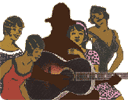
Just finished reading this book, have mixed feelings about it but still recommend it to Weenies and others interested in the history of recorded music, especially blues and hillbilly/country music.
Here?s how the publisher (Duke University Press) promotes the book:
?In Segregating Sound, Karl Hagstrom Miller argues that the categories that we have inherited to think and talk about southern music bear little relation to the ways that southerners long played and heard music. Focusing on the late nineteenth century and the early twentieth, Miller chronicles how southern music?a fluid complex of sounds and styles in practice?was reduced to a series of distinct genres linked to particular racial and ethnic identities. The blues were African American. Rural white southerners played country music. By the 1920s, these depictions were touted in folk song collections and the catalogs of ?race? and ?hillbilly? records produced by the phonograph industry. Such links among race, region, and music were new. Black and white artists alike had played not only blues, ballads, ragtime, and string band music, but also nationally popular sentimental ballads, minstrel songs, Tin Pan Alley tunes, and Broadway hits.?
Miller?s argument shouldn?t be very earthshaking to people who frequent this website, or who have even a rudimentary understanding of how Jim Crow mentality pigeonholed black performers into recording certain types of music and denied them any opportunities to cross over into ?white? genres.
For me the book?s strong points include its review of factors leading up to that hard-core segregation: touring theatre groups in the 1870s and 1880s; the sheet music publishing industry; white performers who specialized in blackface, minstrel, and ?coon song? acts; and the emergence of academics who created a new field of study known as folklore. No one comes out smelling very good. Each group accepted and encouraged images that combined outright racism, a romanticized version of the antebellum South, and a totally imagined Africa filled with ?tom-tom-playing savages.? The misconceptions on the part of supposedly learned people in academia are mind-boggling.
Miller shows how ?hillbilly? music also emerged from similar romanticized images, but with a major difference: performers under that label were free to play popular tunes coming out of Tin Pan Alley as long as they made them sound ?down home.? For black performers, it was either record a blues or a novelty song projecting racist images, or go out on the street, where they could play whatever they wanted. Again, Miller repeatedly makes a point that many of us have understood for a long time: the artists that we love so much for their country blues output were fully capable of playing love songs, pop ditties, polkas?in short, whatever they liked listening to. But when they played those other kinds of songs for talent scouts like Ralph Peer, they were rejected outright.
The book is based on a dissertation, so sometimes the going gets tough in terms of readability. There?s some small but annoying factual errors that Weenies will pick up on?for instance, Miller places Bill Broonzy?s famous quote about folk music not being sung by horses in the context of a 1962 issue of Time magazine, giving a strong impression that Big Bill was still alive when that issue was published. But overall the book is worthwhile in terms of presenting the big picture of how business and academic interests as far back as the 1870s influenced decisions about what was acceptable for consumers to listen to, what wasn?t, and how those decisions were deeply connected to race.
Here's a link to the Duke University Press web page for this book: http://www.dukeupress.edu/Catalog/ViewProduct.php?productid=12782
Lindy









 Logged
Logged

